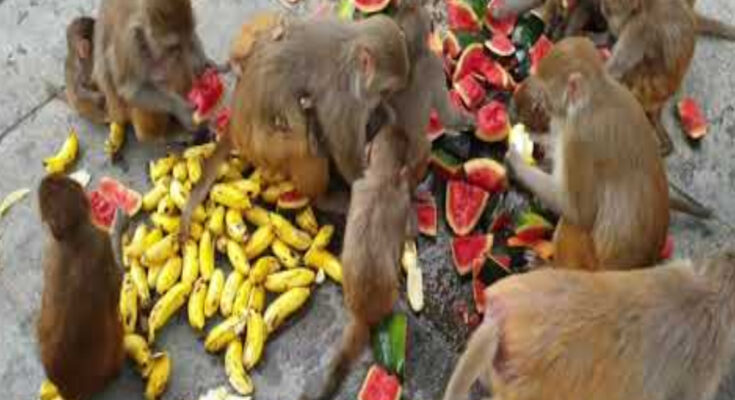In the bustling city of Varanasi, where the sacred Ganges River flows and the air is thick with spiritual energy, there lived a man named Rajesh. He was known for his unwavering devotion and kind heart, which extended not only to the people around him but also to the revered Hanuman, the monkey god. This essay chronicles Rajesh’s daily ritual of feeding food and fruits to the Hanuman G, an act that symbolizes deep faith, compassion, and the timeless bond between humans and the divine.
Every morning before the break of dawn, Rajesh would rise from his humble abode and prepare for his daily pilgrimage. His small home was modestly adorned with images of various Hindu deities, with a special altar dedicated to Lord Hanuman. Rajesh believed that feeding Hanuman was not just a religious duty but an expression of his gratitude and love for the deity who epitomized strength, devotion, and selfless service.
Rajesh meticulously selected fresh fruits and prepared a simple yet hearty meal. Bananas, guavas, and papayas were his favorites, as these were believed to be preferred by Hanuman. Alongside the fruits, he would prepare a small bowl of rice and lentils, cooked with care and infused with the warmth of his devotion.
With a basket of offerings in hand, Rajesh would make his way to the ancient Hanuman temple situated on the banks of the Ganges. The temple, with its towering idol of Hanuman, was a place of solace and spiritual refuge for many. As the first rays of the sun kissed the temple’s spires, Rajesh would reach the sanctum, his heart brimming with reverence.
Kneeling before the idol, he would lay out the food and fruits, chanting prayers and hymns in praise of Hanuman. This daily ritual was not just about feeding a deity; it was an intimate conversation between a devotee and his god, a moment where Rajesh felt a profound connection to the divine presence of Hanuman.
The act of feeding Hanuman held deeper significance than mere sustenance. In Hindu mythology, Hanuman is revered as the protector of the weak and the remover of obstacles. Rajesh believed that by offering food, he was inviting Hanuman’s blessings into his life and the lives of those around him. The ritual was a way of seeking protection, strength, and guidance from the deity who exemplified these virtues.
Rajesh’s offerings did not go unnoticed. The temple priests and fellow devotees admired his unwavering dedication. Many would join him, inspired by his simple yet profound act of devotion. The temple grounds would come alive with the sound of prayers, the scent of incense, and the sight of people coming together in a shared moment of spiritual connection.
Beyond its religious significance, Rajesh’s daily ritual was a testament to his compassionate nature. Feeding Hanuman symbolized his respect for all living beings, reflecting the belief that the divine resides in every creature. This act of kindness extended beyond the temple; Rajesh was known in his community for his generosity and willingness to help others, mirroring the selfless service that Hanuman himself embodied.
Rajesh’s story is a poignant reminder of the power of faith and the profound impact of simple acts of devotion. His daily ritual of feeding food and fruits to Hanuman transcended religious practice, embodying a deeper spiritual connection and a heartfelt expression of compassion.
In a world often consumed by material pursuits, Rajesh’s unwavering devotion and kindness stand as a beacon of hope and inspiration. His story encourages us to find divinity in everyday acts of love and service, reminding us that true devotion lies not just in grand gestures but in the sincerity of our hearts and the compassion we extend to all beings.
Through his daily offerings to Hanuman, Rajesh forged a timeless bond with the divine, a bond that continues to inspire and uplift those who witness his humble yet powerful act of feeding the god he so deeply revered.



